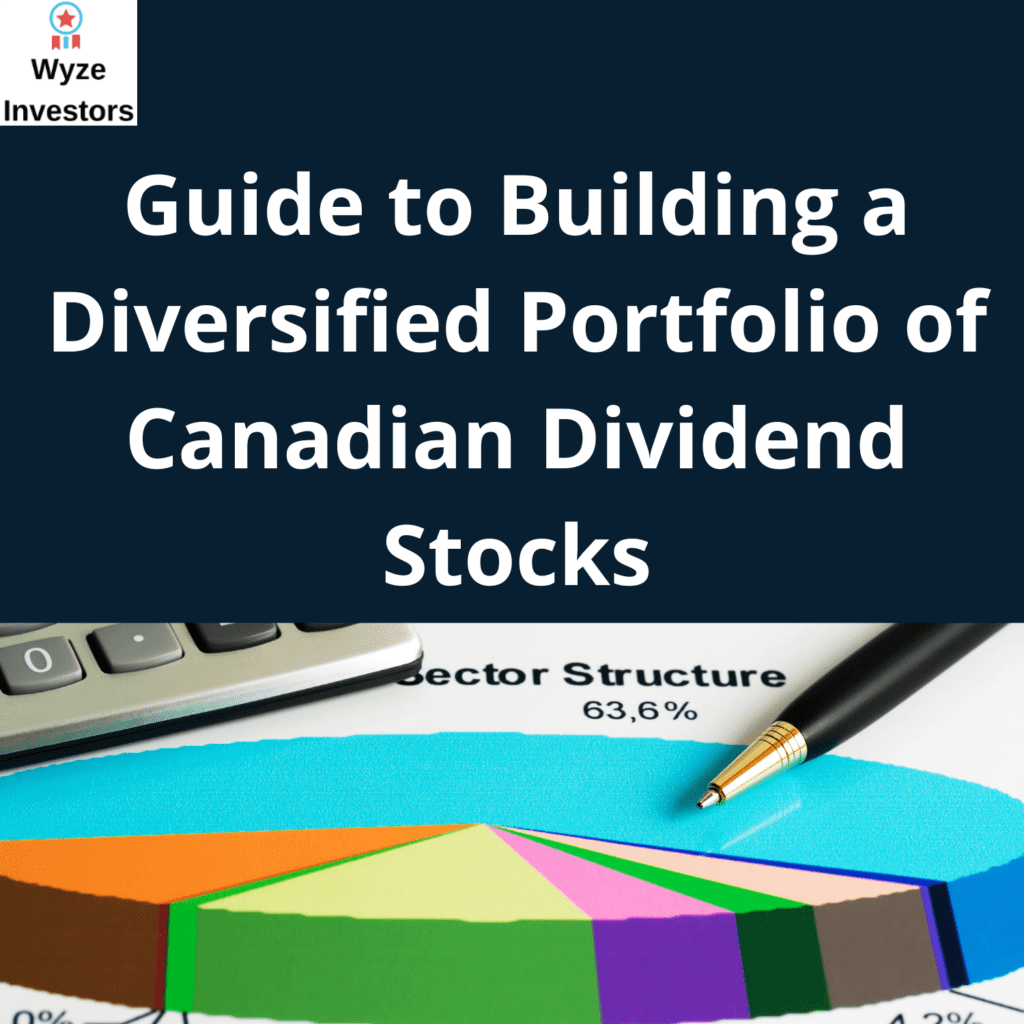Building a portfolio of Canadian dividend stocks is an effective strategy for generating passive income while diversifying your investments. Spreading investments across multiple economic sectors can not only limit the risks associated with fluctuations in a particular sector, but also take advantage of the regular dividends paid by well-established companies in Canada.

This article presents a selection of the best Canadian stocks by sector, with a focus on key sectors such as financials, energy, telecommunications, utilities and consumer goods.
How to Build a Canadian Dividend Portfolio: Sector Allocation
Creating a well-diversified portfolio of Canadian dividend stocks is based on a sector allocation tailored to each investor’s passive income objectives and risk tolerance. This article provides a list of the best Canadian dividend stocks by sector, as well as a suggested sector allocation. The distribution indicated is only a suggestion; It is essential that each investor adjusts the percentages according to their needs. For example, if your priority is revenue stability and predictability, you may want to place greater emphasis on the utilities and telecommunications sectors. Conversely, a more growth-oriented approach could overweight sectors such as consumer goods and energy, which offer the prospect of high returns although they are sometimes more volatile.
To build this sector allocation, you can also take inspiration from popular dividend ETFs such as the Vanguard FTSE Canadian High Dividend Yield Index ETF (ETF: VDY), the iShares Canadian Select Dividend Index ETF (ETF: XDV), and the iShares Core S&P/TSX Composite High Dividend Index ETF (ETF: XEI), which allocate their assets based on the dividend performance of Canadian companies. These ETFs offer an indicative sector allocation that can serve as a starting point, but it’s always best to tailor the allocation based on your analysis and view of each sector’s potential returns.
Popular Canadian Dividend Stocks by Sector
Financial sector (30-35%)
The financial sector is crucial in a Canadian dividend portfolio. While Canada’s largest banks have a significant share, it is recommended to diversify slightly to avoid overexposure. You could allocate about 30% of the portfolio to banks like Royal Bank of Canada (RY), Bank of Montreal (BMO) and Bank of Nova Scotia (SNB). These institutions offer generous and regular dividends, but it makes sense to supplement this allocation with non-bank financial securities, such as insurance or asset management companies, to limit the risks associated with the banking sector.
| Ticker | Enterprise | Dividend(%) | Description |
| RY | Royal Bank of Canada | About 4.1% | Canada’s largest bank by capitalization, known for its consistent dividends. |
| BMO | Bank of Montreal | About 4.3% | Historic bank with prudent management and more than 190 years of continuous dividends. |
| BNS | Bank of Nova Scotia | About 6% | Offers a high dividend with significant exposure to international markets. |
| TD | Toronto-Dominion Bank | About 4.0% | Strong presence in Canada and the United States with steadily increasing dividends. |
| CM | Canadian Imperial Bank (CIBC) | About 5.5% | Attractive dividend, with a strong track record of financial stability. |
| NA | National Bank of Canada | About 4.2% | Well positioned in Quebec, with stable dividend growth. |
| MFC | Manulife Financial | About 5.7% | Insurance company offering a high and diversified dividend internationally. |
Energy sector (20-25%)
With Canada being a major producer of oil and gas, the energy sector is a source of high dividends. Companies like Enbridge Inc. (ENB) and TC Energy Corp (TRP), known for their oil and natural gas transportation infrastructure, are offering attractive dividends. To add resilience, you could also include Canadian Utilities (CU), which, while classified as a utility, has diversified businesses in renewable energy. The entire sector offers solid incomes but is also exposed to some volatility related to commodity prices.
| Ticker | Enterprise | Dividend yield (%) | Description |
| ENB | Enbridge Inc. | About 7.5% | Oil and natural gas transportation, leader in energy infrastructure. |
| TRP | TC Energy Corp | About 6.8% | Natural gas pipeline network and projects, active in North America. |
| CU | Canadian Utilities | About 4.7% | Diversified into energy and utilities, appreciated for the regularity of its dividends. |
| SU | Suncor Energy | About 4.9% | Integrated player in the oil industry, present in production and refining. |
| CNQ | Canadian Natural Resources | About 4.5% | One of the largest independent oil and gas producers. |
| IMO | Imperial Oil | About 3.2% | ExxonMobil’s Canadian subsidiary, specializing in exploration and refining. |
| RNW | TransAlta Renewables | About 6% | Producer of renewable energy (wind and hydroelectricity) in Canada. |
Services publics (15-20%)
Utilities, such as Fortis Inc. (FTS), Algonquin Power & Utilities Corp (AQN), and Hydro One Ltd. (H), are ideal for a stable portion of the portfolio. These companies provide essential services (electricity and gas) and are known for their resilience in bear market times. With often regular dividends and increased cash flow predictability, utilities form a safe foundation in a dividend portfolio.
| Ticker | Enterprise | Dividend yield (%) | Description |
| FTS | Fortis Inc. | About 4.3% | Well-diversified electric and gas company with assets in North America. |
| AQN | Algonquin Power & Utilities Corp | About 6% | Focused on renewable energy and traditional utilities. |
| H | Hydro One Ltd. | About 3.5% | Ontario’s electricity supplier, valued for its financial stability. |
| EMA | Emera Inc. | About 5.0% | Electricity and gas in North America, which is very involved in clean energy. |
| CU | Canadian Utilities | About 4.7% | ATCO’s Utilities Division, diversified into utilities. |
| NPI | Northland Power | About 4.5% | Independent producer of clean energy, including wind and solar. |
| INE | Innergex Renewable Energy | About 4% | Renewable energy specialist, with assets in Canada and internationally. |
Telecommunications (10-15%)
The telecommunications sector is another pillar for generating passive income in Canada.Inc. (BCE),TelusCorporation (T)andRogers Communications (RCI. B)are the main players offering competitive dividends. These companies are benefiting from a constant demand for communication services, particularly with the deployment of 5G. This stability makes the telecom sector an essential component for investors looking for regular income.

| Ticker | Enterprise | Dividend yield (%) | Description |
| BCE | BCE Inc. | About 6.2% | Leading Canadian telecom provider, with stable revenues and a high dividend. |
| T | Telus Corporation | About 5.5% | Strong presence in mobile and digital health, known for its dividend growth policy. |
| RCI.B | Rogers Communications | About 3.2% | A player in 5G and mobile telephony, with a growing dividend. |
| QBR.B | Quebecor Inc. | About 4.5% | Present in Quebec, diversified into cable, internet, and media. |
| SJR.B | Shaw Communications | About 3.8% | Telecommunications and Internet services provider, recently acquired by Rogers. |
| MBT | Manitoba Telecom Services (Bell MTS) | About 4.0% | Specializes in telecommunications services in Manitoba. |
| CGO | Cogeco Inc. | About 2.4% | Internet and cable service provider, expanding in Eastern Canada. |
Consumer staples (10-15%)
For further diversification, including consumer staples is essential. Metro Inc. (MRU), George Weston Ltd. (WN), and Empire Company Ltd. (EMP. A) are strong companies operating in essential sectors such as food and basic necessities. Although their dividend yields are often lower than in other sectors, these companies provide resilience to economic cycles. They are therefore a protection against consumption drops in difficult times.
Consumer Goods Sector: Food & Essentials
| Ticker | Enterprise | Dividend yield (%) | Description |
| MRU | Metro Inc. | About 1.5% | Grocery and drug chain is the leader in Quebec and Ontario with stable dividend growth. |
| WN | George Weston Ltd. | About 1.8% | Parent company of Loblaw, well diversified into food and retail. |
| EMP.A | Empire Company Ltd. | About 2% | Owner of Sobeys and IGA, well established in the Canadian food sector. |
| L | Loblaw Companies Ltd. | About 1.6% | Leading food and pharmacy retailer, with FMCG brands. |
| SAP | Saputo Inc. | About 2.2% | A major producer of dairy products, present in Canada and internationally. |
| ATD | Alimentation Couche-Tard | About 0.9% | Convenience store chain, very active in acquisitions and global expansion. |
| DOL | Dollarama Inc. | About 0.4% | Leader in discount stores in Canada, with rapid expansion and low dividend. |
How to Select Dividend Stocks: Key Ratios and Stability Criteria
Here are the key elements and ratios to consider, as well as an overview of the “Dividend Aristocrats“, the companies that are particularly reliable for investors looking for dividends.
1. Key Ratios for Valuing Dividend Stocks
Dividend Yield: The dividend yield is a ratio that measures the ratio of the annual dividend per share to the share price. For example, a stock listed at $100 with an annual dividend of $4 will have a yield of 4%. This ratio allows for a comparison of the returns of different stocks, but a return that is too high can signal increased risk, as distressed companies may temporarily maintain a high dividend to attract investors.
Payout Ratio: This ratio indicates the share of profits that a company devotes to dividends. A payout ratio above 80% may indicate that the company is spending a large portion of its profits on dividend payments, which may limit its ability to invest in growth. Ideally, a payout ratio between 40% and 60% is considered healthy.
Dividend Growth: A history of dividend growth is a good indicator of a company’s stability and financial health. Companies that are able to increase their dividends every year often show strong financial management and an ability to generate stable revenue.
Price-to-earnings (P/E) ratio: While the P/E ratio is primarily a valuation indicator, it can help identify stocks that are reasonably priced relative to earnings. A P/E that is too high could signal a risk of a price correction, which could affect the value of the investment, even if dividends remain stable.
2. The Importance of Dividend History
The history of paying dividends is another essential criterion. Companies that have paid dividends regularly over several decades are often perceived as stable and resilient to economic crises. This history indicates financial strength and a management policy aimed at rewarding shareholders. For example, Canadian companies such as the Royal Bank of Canada and Enbridge have demonstrated consistency in their dividends, even during a recession.
3. The ‘Dividend Aristocrats’
In Canada, aristocratic stocks have slightly different criteria than their U.S. counterparts. Here, the minimum required to be considered an Aristocrat Dividend is to have increased its dividends for at least 5 consecutive years. Although this threshold is less demanding than the 25-year threshold in the United States, it remains a sign of solidity and consistency for companies that meet this criterion. These companies are often leaders in their respective industries, with prudent financial management and a stable business model that allows them to reward their shareholders year after year.
The Canadian Dividend Aristocrats are mainly present in stable and well-established sectors, such as financials, utilities, and energy. Among them are companies like Fortis Inc., which has increased its dividend for more than 45 consecutive years, BCE Inc., and Canadian Utilities, all of which are recognized for their consistency in dividend payments. These companies offer investors peace of mind, as they are able to generate stable cash flows even in periods of economic volatility.
Investing in Canadian Aristocratic Dividends can therefore be an attractive strategy for investors looking for stable and growing sources of income over the long term, while having a portfolio that is less vulnerable to market fluctuations.
Conclusion
Building a diversified portfolio of Canadian dividend stocks is a smart strategy for generating passive income while minimizing risk. By allocating their investments across different sectors, each investor can tailor their portfolio to their goals, whether it’s stability, growth, or dividend optimization. While this article offers a sector allocation and a selection of popular stocks in key sectors like financials, energy, telecommunications, utilities, and consumer goods, it is essential that each investor adjusts these recommendations based on their own financial goals and risk tolerance. By drawing on the allocations of popular Canadian ETFs such as VDY, XDIV and XEI, and regularly re-evaluating the performance of each sector, it is possible to build a balanced portfolio that can generate strong income and withstand market fluctuations.

